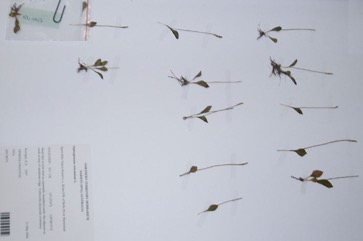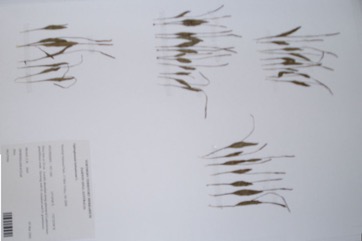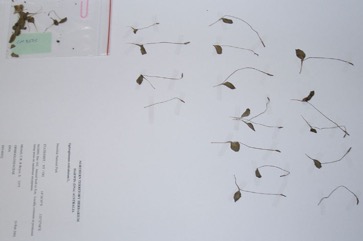Adder’s tongue fern

A tropical plant. It grows amongst grass in open forest. In Nepal it grows up to 1400 m altitude. In West Africa to 1,500 m altitude. In Argentina it grows from sea level to 1,600 m above sea level. It grows in moist, shady places. It grows in sandy soils and in seasonally wet places.
Also known as:
Apatia, Ayoborbok, Bilai gangse, Chukut sadaun, Chukut siraru, Ek patiya, Ektir, Gabachak, Isangutshane, Isankuntshane, Isa nki ntana, Jibha, Jibre dhap, Jibre sag, Jukut siraru, Lai gangse, Nakkuneeti, Runs, Ruus, Suga, Yimuyidun
Edible Portion
- Fronds, Leaves, Stem, Vegetable
Where does Adder’s tongue fern grow?
Found in: Africa, American Samoa, Argentina, Asia, Australia, Brazil, Burkina Faso, Cameroon, Central Africa, Central America, China, Congo, East Africa, Equatorial-Guinea, Eswatini, Haiti, Himalayas, India, Korea, Lord Howe Island, Madagascar, Malawi, Malaysia, Mauritius, Micronesia, Mozambique, Nepal, Northeastern India, Pacific, Palau, Papua New Guinea, PNG, Paraguay, SE Asia, Sierra Leone, Solomon Islands, South Africa, Southern Africa, South America, Swaziland, Tanzania, Tibet, Uruguay, West Africa, Zambia, Zimbabwe, Zululand
Notes: There are about 30 Ophioglossum species. They grow in both tropical and temperate regions. It is a nutritious vegetable.
Status: It is a locally popular vegetable.
Growing Adder’s tongue fern
Cultivation: Plants are grown from spores. They can also be grown from parts of the roots (rhizomes).
Edible Uses: The fronds are cooked as a vegetable. They are also used in salads. The leaves should only be very lightly cooked to avoid them turning into slime. The harvested plants can be stored for 5-6 days. They are also cooked in stir fried dishes and added to soups.
Production: It is only present above ground in the rainy season. Harvesting can start after 6 months with plants grown from rhizomes. When grown from spores it takes 1-2 years.
Nutrition Info
per 100g edible portion| Edible Part | Energy (kcal) | Protein (g) | Iron (mg) | Vitamin A (ug) | Vitamin c (mg) | Zinc (mg) | % Water |
|---|---|---|---|---|---|---|---|
| - | - | - | - | - | - |
Adder’s tongue fern Photos



References
Ambasta, S.P. (Ed.), 2000, The Useful Plants of India. CSIR India. p 409
Borrell, O.W., 1989, An Annotated Checklist of the Flora of Kairiru Island, New Guinea. Marcellin College, Victoria Australia. p 6
Burkill, H. M., 1985, The useful plants of west tropical Africa, Vol. 4. Kew.
Burkill, I.H., 1966, A Dictionary of the Economic Products of the Malay Peninsula. Ministry of Agriculture and Cooperatives, Kuala Lumpur, Malaysia. Vol 2 (I-Z) p 1610
Chaffey, C.H., 1999, Australian Ferns. Growing them successfully. Kangaroo Press. p 11, 189, 204
Chin, W.Y., 1998, Ferns in the Tropics. Kangaroo. p 146
Dangol, D. R. et al, 2017, Wild Edible Plants in Nepal. Proceedings of 2nd National Workshop on CUAOGR, 2017.
Dobriyal, M. J. R. & Dobriyal, R., 2014, Non Wood Forest Produce an Option for Ethnic Food and Nutritional Security in India. Int. J. of Usuf. Mngt. 15(1):17-37
Dutta, U., 2012, Wild Vegetables collected by the local communities from the Churang reserve of BTD, Assam. International Journal of Science and Advanced Technology. Vol. 2(4) p 122
Elliot, W.R., & Jones, D.L., 1997, Encyclopedia of Australian Plants suitable for cultivation. Vol 7. Lothian. p 106
Flora of Australia Volume 49, Oceanic Islands 1, Australian Government Publishing Service, Canberra. (1994) p 552
Flora of Solomon Islands
Fox, F. W. & Young, M. E. N., 1982, Food from the Veld. Delta Books. p 227
Gallagher, D. E., 2010, Farming beyond the escarpment: Society, Environment, and Mobility in Precolonial Southeastern Burkina Faso. PhD University of Michigan.
Grubben, G. J. H. and Denton, O. A. (eds), 2004, Plant Resources of Tropical Africa 2. Vegetables. PROTA, Wageningen, Netherlands. p 404
HELY- HUTCHINSON,
Heyne, K., 1927, p 95
Joshi, N., et al, 2007, Traditional neglected vegetables of Nepal: Their sustainable utilization for meeting human needs. Tropentag 2007. Conference on International Agricultural Research for Development.
Ju, Y., et al, 2013, Eating from the wild: diversity of wild edible plants used by Tibetans in Shangri-la region, Yunnan, China, Journal of Ethnobiology and Ethno medicine 9:28
Long, C., 2005, Swaziland's Flora - siSwati names and Uses http://www.sntc.org.sz/flora/
Manandhar, N.P., 2002, Plants and People of Nepal. Timber Press. Portland, Oregon. p 338
Maroyi, A., 2014, Not just minor wild edible forest products: consumption of pteridophytes in sub-Saharan Africa. Journal of Ethnobiology and Ethnomedicine. 10:78
Narayanan Ratheesh, M. K. et al, 2011, Wild edible plants used by the Kattunaikka, Paniya and Kuruma tribes of Wayanad District, Kerala, India. Journal of Medicinal Plants Research Vol. 5(15), pp. 3520-3529
Ochse, J. J. et al, 1931, Vegetables of the Dutch East Indies. Asher reprint. p 545
Ojha, R. & Devkota, H. P., 2021, Edible and Medicinal Pteridophytes of Nepal: A Review. Ethnobotany Research & Applications 22:16
Paczkowska, G. & Chapman, A.R., 2000, The Western Australian Flora. A Descriptive Calatogue. Western Australian Herbarium. p 25
Patiri, B. & Borah, A., 2007, Wild Edible Plants of Assam. Geethaki Publishers. p 164
Peekel, P.G., 1984, (Translation E.E.Henty), Flora of the Bismarck Archipelago for Naturalists, Division of Botany, Lae, PNG. p 30, 29
Piggott, A. G. 1988, Ferns of Malaysia in Colour. Tropical press, Malaysia. p 28
Ruiters-Welcome, A. K., 2019, Food plants of southern Africa. Ph.D. thesis. Univ. of Johannesburg p 83
Sakar, A. & Das, A. P., 2018, The traditional knowledge on edible wild leafy vegetables of Rabha Tribe in Duars of North Bengal: a potential reinforcement to food security. Pleione 12(2): 275 - 281. 2018.
Sarma, H., et al, 2010, Updated Estimates of Wild Edible and Threatened Plants of Assam: A Meta-analysis. International Journal of Botany 6(4): 414-423
Singh, K.K., & Maheshwari, J.K., 1984, Studies of the Flora of Dudwa National Park. Kheri District, U.P. (Part 1) J. Econ. Tax. Bot. Vol 5 No. 2 pp 379-
Swaziland's Flora Database http://www.sntc.org.sz/flora
Taram, M., et al, 2018, Wild Food Plant Resources of Komkar Adi Tribe of Upper Siang District in Arunachal Pradesh, India. Bulletin of Arunachal Forest Research, Vol. 33(2), 27-35
Uprety, Y., et al, 2010, Non-timber Forest Products in Bardiya District of Nepal: Indigenous Use, Trade and Conservation. J Hum Ecol, 30(3): 143-158
Uprety, Y., et al, 2012, Diversity of use and local knowledge of wild edible plant resources in Nepal. Journal of Ethnobotany and Ethnomedicine 8:16
Wheeler, J.R.(ed.), 1992, Flora of the Kimberley Region. CALM, Western Australian Herbarium, p 28
World Checklist of Useful Plant Species 2020. Royal Botanic Gardens, Kew